Getting and Giving Wisdom about ADR
Recently, on September 16th, I spent an entire day at an American Bar Association TIPS (Tort Trial and Insurance Practice Section) Seminar. A friend had asked me to participate in this seminar months ago, and I readily accepted, hoping to offer a plaintiff’s attorney perspective on why arbitration and other forms of alternative dispute resolution can work for all parties.
The Seminar
For an entire day, various speakers and panelists shared wisdom about arbitration, mediation, and alternative dispute resolution (ADR) in general. We had some “bold print” names from all across the country, from those who had handled the response to the George Floyd murder in Minneapolis-St. Paul, to lawyers who dealt with the 9/11 compensation fund as well as the Virginia Tech and Columbine shootings.
Somehow, I was included with such luminaries of the profession.
My particular panel included a law professor, a judge and a professional mediator. My role was to focus on why more lawyers won’t arbitrate, and why more plaintiffs should use this dispute resolution tool to resolve cases.
We all offered our unique perspectives, combining about 200 years of legal experience.
What is Alternative Dispute Resolution?
Alternative dispute resolution (ADR) is merely a catch-all term for the multiple methods for resolving disputes short of trial, and includes mediation and arbitration.
Arbitration is, in essence, a “mini-trial” before either a single arbitrator or a three-person panel (typically, an arbitrator chosen by each side, plus a neutral both agree to). The arbitrator or panel acts as the judge in the case.
The only differences from a trial are the lack of a jury, the somewhat relaxed evidentiary rules (using a doctor’s report as opposed to having a doctor testify live, or by an evidentiary deposition), and there is no motion practice—all disputes, stipulations, exclusions etc. are determined before the case is arbitrated. This saves a great deal of time and money compared to going to trial.
Arbitration takes multiple forms. It can be non-binding, meaning that either side can reject the arbitration award and proceed to trial. Or it can be binding, so that the ruling of the arbitrator or panel is final and resolves the case.
Mediation is another ADR process that involves a neutral third party trying to help two or more parties in conflict reach a resolution of their case. Unlike an arbitrator, a mediator doesn’t act as a judge, but as a facilitator.
Mediation can take the form of “shuttle diplomacy,” in which the mediator shuttles back and forth between separate rooms where the parties are located, relaying offers and demands. The mediator can ask the parties more directly for top- and bottom-line settlement offers or acceptances. The mediator can coax parties toward settlement for what he or she believes the value of the case is, or may use a combination of all these techniques. Most of the time, mediation is not binding, but, as in most things involving the law, almost anything can be negotiated.
What I Said at the Seminar
My main point was that if you want to resolve a case that is neither so bad, nor so outstanding, that it should go to trial, you might want to save your client years of waiting and tens or hundreds of thousands of dollars, and go to arbitration.
While most of my experience with arbitration involves uninsured or underinsured motorist insurance claims), I have also arbitrated many cases in the Cook County Mandatory Arbitration system for nearly thirty-five years.
No single type of arbitration is ideal for every case. Obviously, if you have a blockbuster case, you will want your lawyer to ask a jury for a huge verdict. Similarly, if your case is terrible, you might not have any way to resolve it other than by a jury trial.
However, even in these cases, there are creative options, such as agreeing to “double-blind high-low” arrangements. For example, if the insurance policy limits are $100,000 and the prior offer to settle is $25,000, perhaps your attorney can set a high-low arbitration of $25,000 low and $100,000 high with the other side. The arbitrator won’t know about this agreement, but you take your case to arbitration and wind up with something even if you lose, while the defense won’t sweat too much with its liability limited to the top end of the policy.
I will always be a hater of contractually-required arbitration clauses, which are generally anti-consumer, and one-sided (pro-big company). But if you choose to arbitrate, there are many clever ways to resolve your case without the stress, expense, and time-consuming nature of a trial.
Takeaways
- ADR offers methods to resolve cases that can be tailored to the specific details of the case
- Mediation and arbitration have a variety of tweaks that can be applied to find the right fit for each case
Contact Chicago Personal Injury Lawyer Stephen Hoffman
If you have been injured, whether by an auto accident, bike or pedestrian crash, dog bite, work accident, or medical malpractice, seek medical attention immediately. Report accidents to the police and your own insurance company, or to your employer if you were injured at work. Then contact a lawyer with experience in your type of injury matter.
If you have been in an accident and have questions, contact Chicago personal injury attorney Stephen L. Hoffman for a free consultation at (773) 944-9737. Stephen has over 30 years of legal experience and gets results; he has collected millions of dollars for his satisfied clients. He is listed as a SuperLawyer, has a 10.0 rating on Avvo, and is BBB A+ accredited. Stephen is also an Executive Level Member of the Lincoln Square Ravenswood Chamber of Commerce.
Stephen handles injury cases on a contingency fee basis, which means you pay nothing up front, and Stephen only gets paid if you do. You have only a limited time to file a claim, so don’t wait another day; contact Stephen now to get started putting your life back together.













